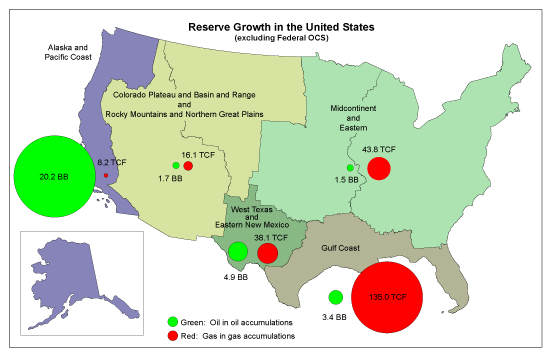Reserve Growth in the United States
 Potential additions to proven oil and gas reserves equal about 10
percent of the overall U.S. oil and gas endowment, according to a recent
U.S. Geological Survey (USGS) estimate of reserve growth in conventional
reservoirs. The USGS estimates that the mean potential undiscovered,
conventional reserve additions for the United States total 32 billion
barrels (bb) of oil, 291 trillion cubic feet (tcf) of natural gas, and
10 bb of natural gas liquids (NGL).
Potential additions to proven oil and gas reserves equal about 10
percent of the overall U.S. oil and gas endowment, according to a recent
U.S. Geological Survey (USGS) estimate of reserve growth in conventional
reservoirs. The USGS estimates that the mean potential undiscovered,
conventional reserve additions for the United States total 32 billion
barrels (bb) of oil, 291 trillion cubic feet (tcf) of natural gas, and
10 bb of natural gas liquids (NGL).The estimates are for technically recoverable oil and gas, and do not include reserve growth estimates for Federal offshore areas. These estimates were made using a new assessment methodology developed by the USGS. Unlike past estimates of reserve growth that relied on statistical extrapolations of growth trends, the new USGS assessment is based on detailed analysis of geology and engineering practices used in producing fields. The assessment uses both published and commercial sources of geologic information and field-production data.
Reserve growth is the increase in estimated volumes of oil and natural gas that can be recovered from discovered (known) fields and reservoirs through time. Most reserve growth results from delineation of new reservoirs, field extensions, or improved recovery techniques, thereby enhancing efficiency, and recalculation of reserves due to changing economic and operating conditions.
These volumes represent an estimate of the potential future growth of current U.S. reserve estimates over time based on current technologies, and greater understanding of current reservoirs, among other advances. For comparison, the current mean USGS estimates for undiscovered, technically recoverable conventional oil and gas resources from onshore and underlying State waters in the United States are 27 bb of oil and 388 tcf of natural gas, respectively.
Reserve growth is a component of the overall oil and gas endowment, but is distinct from reserves and from undiscovered, technically recoverable resources – all three are important but separate measurements used in efforts by industry and government to make energy decisions based on the best available science.
Continuous, or unconventional, oil and gas accumulations, such as shale gas, tight gas, and tight oil were removed from the data set for this study. No attempt was made to estimate the economic viability of the recoverable oil and gas as part of these future projections.
- Press Release & Publication (August 14, 2012)